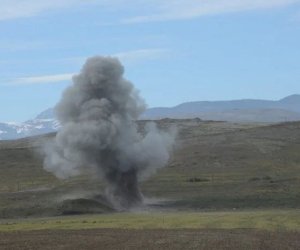Colorful Hand of God is spotted in Space by X-ray telescope - PHOTO

An X-ray telescope has captured the 'Hand of God' in space. NASA's Nuclear Spectroscopic Telescope Array, or NuStar, captured the new image of a dead star nicknamed the 'Hand of God' since it looks like an open hand. NuStar has been circling earth since June 2012, on a mission to gather more information about black holes in our universe.'NuStar's unique viewpoint, in seeing the highest-energy X-rays, is showing us well-studied objects and regions in a whole new light,' Fiona Harrison, the mission's principal investigator at the California Institute of Technology in Pasadena, California said on the university's website. This latest image is helping astronomers learn more about pulsars, which are the remnants of dead stars. The 'Hand of God' is a pulsar 17,000 light-years away. It's only about 12 miles in diameter but spins around about seven times in a second throwing around particles from the dead star.Previous images captured of the pulsar made it look like an outstretched hand (shown in red and blue in the picture), but this new image makes it look more like a fist (shown in blue). 'We don't know if the hand shape is an optical illusion,' said Hongjun An of McGill University. 'With NuStar, the hand looks more like a fist which is giving us some clues.'This new picture leads astronomers to believe that the fingers captured in the original picture are physically different areas from the fist. Astronomers also released another of NuStar's latest images, showing black holes throughout space. Each dot shown in the picture is a different black hole in the surrounding galaxies, with the colors representing different types of X-ray light.The red and green dots are what the Chandra X-ray Observatory captured before and the blue dots are the black holes captured by NuStar. The black holes that shine blue are more actively feeding off surrounding clouds of dust and gas. NuStar is the first telescope to capture black holes at such a far distance. The point of finding these black holes is to learn more about the evolution of black holes and the galaxies they belong to. 'This is a hot topic in astronomy,' said Francesca Civano of Yale University. 'We want to understand how black holes grew in the past and the degree to which they are obscured.' (dailymail.co.uk)ANN.Az




































 Photo
Photo 



 Video
Video 

